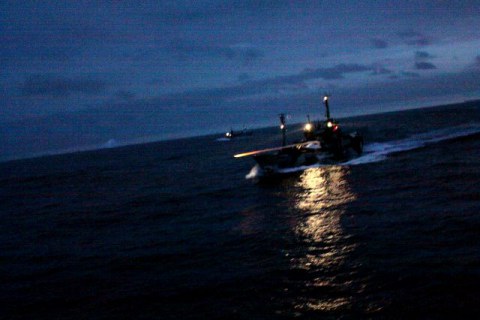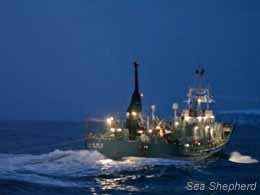Conflict at night on the high seas of the southern ocean whale sanctuary as two Japanese harpoon ships harass Sea Shepherd activists on board the Bob Barker in an attempt to throw them off the tail of the Nisshin Maru whaling factory ship. The weapons in this mini conflict were Tow lines, lasers, spotlights and rockets (flares). The harassment occurred as night was rapidly falling with snow flurries in the air, and within hours of the Bob Barker sighting the Nisshin Maru.
Related youtube videos: Sea Shepherd: The Japanese whaling fleet attacks the Bob Barker - March 5, 2012 | ICR: Bob Barker fires rockets at Yushin Maru 2 - March 5, 2012
 The two Japanese harpoon ships, Yushin Maru No. 2 and Yushin Maru No. 3, repeatedly crossed the bows of the Bob Barker at high speed with 300 metre tow lines in an attempt to foul the activist ship's propellors, according to a Sea Shepherd media release. As the high speed and highly maneuverable harpoon ships harrassed the Bob Barker, spotlights were directed onto the bridge and deck of the Sea Shepherd vessel. Sea Shepherd activists responded by shining lasers back at the two harpoon vessels. According to the ICR up to 40 rockets or flares were also fired towards the two Japanese ships, and there were fiery interchanges over the radio in both Japanese and English.
The two Japanese harpoon ships, Yushin Maru No. 2 and Yushin Maru No. 3, repeatedly crossed the bows of the Bob Barker at high speed with 300 metre tow lines in an attempt to foul the activist ship's propellors, according to a Sea Shepherd media release. As the high speed and highly maneuverable harpoon ships harrassed the Bob Barker, spotlights were directed onto the bridge and deck of the Sea Shepherd vessel. Sea Shepherd activists responded by shining lasers back at the two harpoon vessels. According to the ICR up to 40 rockets or flares were also fired towards the two Japanese ships, and there were fiery interchanges over the radio in both Japanese and English.
Sea Shepherd also alledge that the Japanese harpoon vessels turned off their running lights at times in a breach of maritime safety protocols.
The Institute for Cetecean Research in a press release (PDF) said that "As a measure to maintain security at sea the slower research base vessel the Nisshin Maru (NM) immediately started avoidance steerage while research vessels the Yushin Maru No. 2 (YS2) and the Yushin Maru No. 3 (YS3), repeatedly broadcasted a warning message and towed from their stern a rope with keep-your-distance-warning buoys as a containment measure to make the BB desist from approaching the NM."
Despite the harrassment Sea Shepherd reports that Captain Peter Hammarstedt (27), a veteran of numerous Sea Shepherd campaigns, deftly avoided the fouling lines. There were no injuries on any of the ships according to both sides involved, and the Bob Barker continues to pursue the Nisshin Maru.
The cat and mouse conflict in the icy waters continued for nearly 4 hours, before some calm returned when the Japanese ship captains assessed the Nisshin Maru had reached a 'safe distance' away from the Bob Barker.
“The Bob Barker is 1600 miles south of Tasmania,” said Captain Paul Watson on board the Steve Irwin, presently approaching the Bass Strait and due to arrive in Melbourne within twenty-four hours. “Captain Hammarstedt and his crew are bravely taking on the entire whaling fleet and keeping them on the run. There is no question that this is an exceedingly dangerous conflict but there is also no doubt that it is being highly effective. The Japanese whaling fleet’s kill quota will be greatly reduced this season and we are ready to return once again next season if they decide to continue their illegal slaughter of whales in the Australian Antarctic Territory and the Australian Economic Exclusion Zone.”
Sources:
- Sea Shepherd media release 5 March 2012 - The Night Attack of the Yushins
- Institute for Cetecean Research media release 6 March 2012 (PDF)
- Photo - The Yushin crosses the bow of the Bob Barker with a 300 meter trailing line in an attempt to prop foul the Bob Barker. Photo: Carolina A. Castro (Sea Shepherd)
- Phtoto - 2012.03.05 The Bob Barker fires a rocket signal toward the Yushin Maru No. 2. The Yushin Maru No. 3 is on the back. Photo copyright The Institute of Cetacean Research



Comments
O/K for some but not others. Double standards
Good to see the Japanese ships doing to the Sea Shepard what the Sea Shepard has been doing to them for years. Now the shoe is on the other foot they cry foul LOL
Eating whales is part of Japanese culture they have been doing it as far back as the 12th century if it is O/K for Aboriginals in Australia to Kill and eat protected Animals because it is part of their culture why then is it not O/K for the Japanese to practice their culture?.Whats more cruel killing a whale or a Dugong?don't see much difference myself, except their are more whales in the sea than Dugongs
http://kurrawa.gbrmpa.gov.au/corp_site/info_services/publications/reef_r...
Re: Conflict at night as Japanese whaling vessels harass ...
You make a good point Steve but you must remember it is the activists that decide who can and can't practice their culture.Australian Aboriginal people can do what they want some how their culture is more important that that of the Japanese, you would think because Japan has made a bigger contribution to the world through industry etc they would have been cut a bit of slack but it is the Aboriginal community that gets a bit of slack cut and they have done nothing to advance the world.I think it is the Japanese that should be rewarded not the Aboriginal if any one is allowed to practice their culture it should be the Japanese at least they get off there bum and make things happen
Re: Conflict at night as Japanese whaling vessels harass ...
The Sea Shepard are stopping the indigenous people of Japan practising their culture while they turn a blind eye to the Australian indigenous people who have driven the numbers of Dugong and other animals to a all time low.
It would be interesting to find out why?